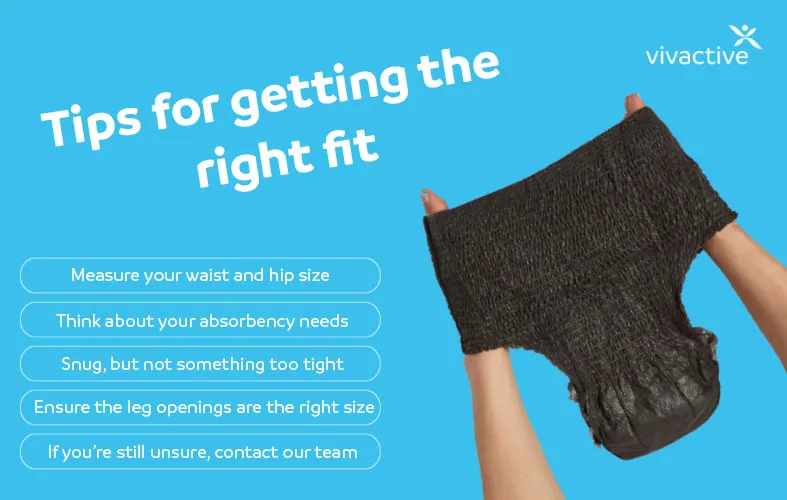
Share this page with friends
Pads, pants and adult nappies: Top tips to get the right fit.

Why's it so important anyway?
Picking the right size and achieving the best fit is essential. Proper fit and sizing of your incontinence products plays a crucial role in the overall management of incontinence. It goes beyond just comfort and convenience, it can also help to prevent leaks and maintain skin health.
Preventing leaks: Let’s start with pants. A well-fitted incontinence pant is designed to provide the best leakage protection. It should have a secure and snug fit around the waist, hips, and leg openings to prevent any urine leakage or accidents. Improperly sized pads and nappies can also be problematic as they can lead to gaps or looseness, increasing the risk of leaks; the last thing you need when you’re out and about with the grandkids!
Vivactive pants, pads and adult nappies offer level of leak prevention as the ‘big brands’ (sometimes even more!) at a far, far, lower cost. We’re not interested in ripping you off like the supermarkets do, we really care about preventing leaks and believe you should be able to do it without a hefty price tag.
Skin health and comfort: An ill-fitted pad or pant can cause friction, chafing, and skin irritation due to constant rubbing or excessive moisture retention. On the other hand, a correctly sized product ensures proper airflow and moisture absorption, reducing the likelihood of skin issues such as rashes, redness, or infections. By prioritising proper fit, individuals can enhance their comfort levels and reduce discomfort.
Mobility and freedom of movement: This is particularly important for adult nappies. Adult nappies that are too loose can shift or bunch up, hindering movement and potentially causing discomfort. But, excessively tight nappies can restrict mobility and lead to discomfort or even circulation problems. A proper fit strikes the balance between security and flexibility, so you can go about your day with ease.
Odour Control: In all instances, properly fitted incontinence items aid in effective odour control. They’re designed to contain and lock in the smell of urine. A secure fit ensures that the absorbent core of the product can work properly, minimising the risk of odour leakage and giving you the confidence to socialise without worrying about unpleasant smells.

Getting the right fit for your incontinence products
Ok, so we’ve covered why you should get the right fit, now seems like a good time to go over how you get the right fit:
- Measure waist and hip size for incontinence pants and nappies: Don’t just guesstimate! Take accurate measurements of your waist and hips using a measuring tape. Once you’ve got an accurate size marked up, refer to the size guidelines provided by the manufacturer to determine the appropriate size range. For example, Vivactive Pants Maxi Large, have the waist/hip measurements in the ‘Product Specification’ tab on the product page.
- For pads, take a look at the length/width: Pads are measured slightly differently to pants. If you head to the product specification tab like we mentioned above, there should be a length, front width and rear width measurement. Consider these measurements when choosing your incontinence pads.
- Consider absorbency needs: Everyone thinks they need the maximum absorbency. Truth is, you might not. Different people have different levels of incontinence, requiring different absorbency levels. If you’re not leaking a huge amount, maybe try a pack of lower absorbancy level and see if they suit you any better. The lower absorbencies are usually a bit cheaper too.
- Snug, but not too tight: Incontinence pants and adult nappies should fit snugly around your waist and hips without being overly tight. A comfortable fit gives you freedom of movement while providing a high level of coverage and protection against leaks.
- Check leg openings: If you’re wearing pants or nappies, make sure the leg openings are secure but not too tight. The elastic should fit comfortably around the thighs to prevent leakage without causing discomfort or leaving marks on the skin.
- Seek professional assistance: If you’re still really concerned about sizing and not sure what to do about it, get in touch with our customer services team and we can talk you through the right products to suit your needs.





